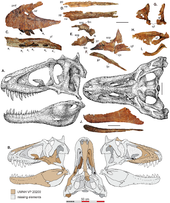Lythronax
| Lythronax | ||||||||||||
|---|---|---|---|---|---|---|---|---|---|---|---|---|

Reconstructed skeletons of (A) Lythronax argestes (UMNH VP 20200) and (B) Teratophoneus curriei (UMNH VP 16690) |
||||||||||||
| Temporal occurrence | ||||||||||||
| Upper Crayon (middle Campanium ) | ||||||||||||
| approx. 80 million years | ||||||||||||
| Locations | ||||||||||||
| Systematics | ||||||||||||
|
||||||||||||
| Scientific name | ||||||||||||
| Lythronax | ||||||||||||
| Loewen et al., 2013 | ||||||||||||
| Art | ||||||||||||
|
||||||||||||
Lythronax was a genus of tyrannosaurid dinosaur from the Campanium of North America . It is the stratigraphically oldest genus of the family Tyrannosauridae. The only species is Lythronax argestes .
description
Lythronax argestes is known from a partially preserved skeleton , which was assigned to a single, not fully grown specimen. The material encloses most of the skull , the pelvis , parts of the left hind leg , a rib and a chevron bone . Diagnostic features include, compared to other tyrannosaurids, the low number of tooth sockets in the upper jaw (11), an inwardly curved, lateral margin of the lower jaw , a high spinous process of the cervical vertebrae and a broad rear part of the skull.
The rostrum makes up less than two thirds of the length of the skull and is therefore comparatively short. The skull is approximately 0.4 times as wide as it is long. The robust upper jaw had heterodontic teeth , as the first five teeth are significantly larger than the remaining six. The skull as a whole is morphologically comparable to that of Tyrannosaurus and Tarbosaurus .
The postcranium is morphologically similar to that of other tyrannosaurids.
Location
Fossil material of the holotype of L. argestes was found in the Wahweap Formation , which lies in Utah ( USA ). The material is in the Natural History Museum of Utah in Salt Lake City under catalog number (UMNH VP 20200). The age of the formation is dated to 80.6 to 79.9 million years , which makes Lythronax the oldest representative of the Tyrannosauridae.
The formation in which it was found was once part of the island continent of Laramidia (now western North America). The discovery of L. argestes suggests that the origin of the Tyrannosauridae was there.
Systematics
Lythronax argestes belonged to the family Tyrannosauridae, a family of large coelurosaurs known mainly from North America and Asia . A detailed phylogenetic analysis from 2013, based on 198 postcranial and 303 cranial traits, classified Lythronax and Teratophoneus as members of the subfamily Tyrannosaurinae. They are also listed as sister taxa of the genera Tyrannosaurus , Bistahieversor , and Tarbosaurus .
literature
- Mark A. Loewen, Randall B. Irmis, Joseph JW Sertich, Philip J. Currie , Scott D. Sampson: Tyrant Dinosaur Evolution Tracks the Rise and Fall of Late Cretaceous Oceans. In: PLoS ONE . Vol. 8, No. 11, 2013, e79420, doi : 10.1371 / journal.pone.0079420 .
Individual evidence
- ↑ a b Loewen et al. 2013, p. 1
- ↑ a b Loewen et al. 2013, p. 2
- ↑ Loewen et al. 2013, p. 6
- ↑ Loewen et al. 2013, p. 8
- ↑ Loewen et al. 2013, p. 9

